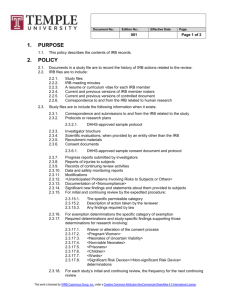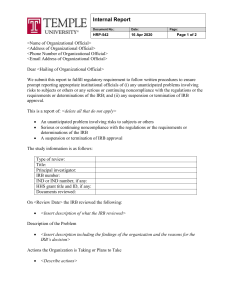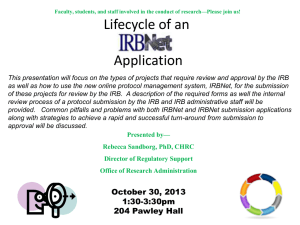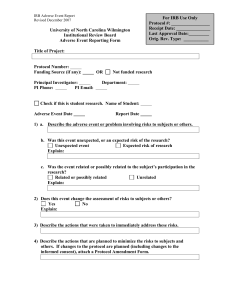POLICY: Definitions (HRP-001)
advertisement
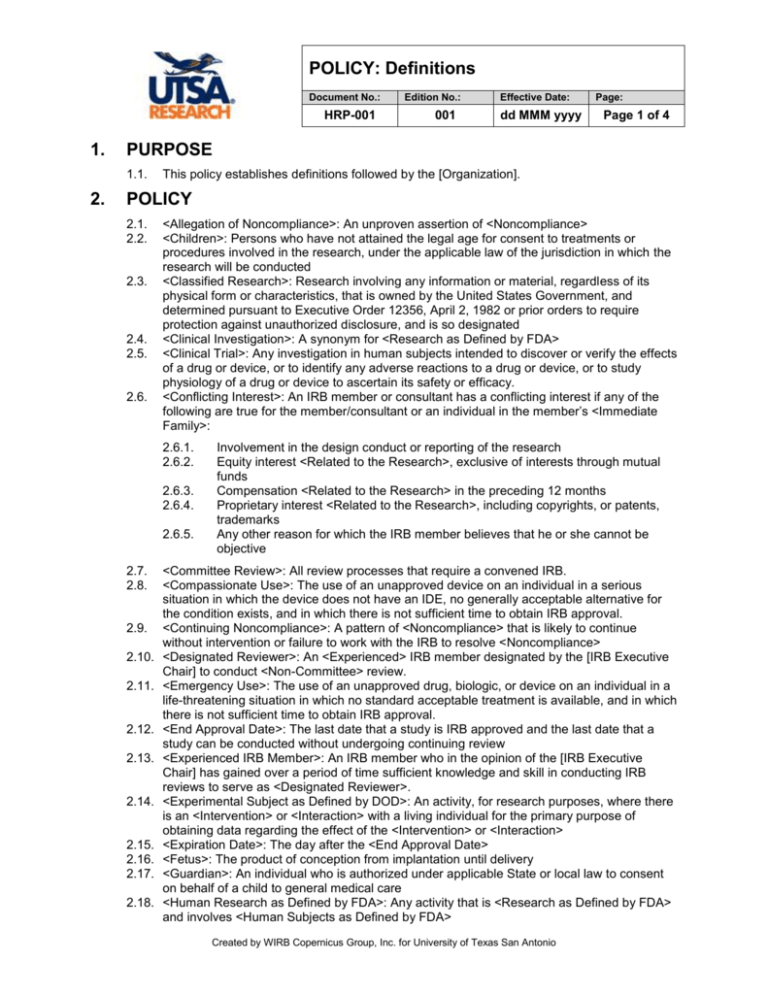
POLICY: Definitions Document No.: HRP-001 1. 001 Effective Date: dd MMM yyyy Page: Page 1 of 4 PURPOSE 1.1. 2. Edition No.: This policy establishes definitions followed by the [Organization]. POLICY 2.1. 2.2. 2.3. 2.4. 2.5. 2.6. <Allegation of Noncompliance>: An unproven assertion of <Noncompliance> <Children>: Persons who have not attained the legal age for consent to treatments or procedures involved in the research, under the applicable law of the jurisdiction in which the research will be conducted <Classified Research>: Research involving any information or material, regardless of its physical form or characteristics, that is owned by the United States Government, and determined pursuant to Executive Order 12356, April 2, 1982 or prior orders to require protection against unauthorized disclosure, and is so designated <Clinical Investigation>: A synonym for <Research as Defined by FDA> <Clinical Trial>: Any investigation in human subjects intended to discover or verify the effects of a drug or device, or to identify any adverse reactions to a drug or device, or to study physiology of a drug or device to ascertain its safety or efficacy. <Conflicting Interest>: An IRB member or consultant has a conflicting interest if any of the following are true for the member/consultant or an individual in the member’s <Immediate Family>: 2.6.1. 2.6.2. 2.6.3. 2.6.4. 2.6.5. 2.7. 2.8. 2.9. 2.10. 2.11. 2.12. 2.13. 2.14. 2.15. 2.16. 2.17. 2.18. Involvement in the design conduct or reporting of the research Equity interest <Related to the Research>, exclusive of interests through mutual funds Compensation <Related to the Research> in the preceding 12 months Proprietary interest <Related to the Research>, including copyrights, or patents, trademarks Any other reason for which the IRB member believes that he or she cannot be objective <Committee Review>: All review processes that require a convened IRB. <Compassionate Use>: The use of an unapproved device on an individual in a serious situation in which the device does not have an IDE, no generally acceptable alternative for the condition exists, and in which there is not sufficient time to obtain IRB approval. <Continuing Noncompliance>: A pattern of <Noncompliance> that is likely to continue without intervention or failure to work with the IRB to resolve <Noncompliance> <Designated Reviewer>: An <Experienced> IRB member designated by the [IRB Executive Chair] to conduct <Non-Committee> review. <Emergency Use>: The use of an unapproved drug, biologic, or device on an individual in a life-threatening situation in which no standard acceptable treatment is available, and in which there is not sufficient time to obtain IRB approval. <End Approval Date>: The last date that a study is IRB approved and the last date that a study can be conducted without undergoing continuing review <Experienced IRB Member>: An IRB member who in the opinion of the [IRB Executive Chair] has gained over a period of time sufficient knowledge and skill in conducting IRB reviews to serve as <Designated Reviewer>. <Experimental Subject as Defined by DOD>: An activity, for research purposes, where there is an <Intervention> or <Interaction> with a living individual for the primary purpose of obtaining data regarding the effect of the <Intervention> or <Interaction> <Expiration Date>: The day after the <End Approval Date> <Fetus>: The product of conception from implantation until delivery <Guardian>: An individual who is authorized under applicable State or local law to consent on behalf of a child to general medical care <Human Research as Defined by FDA>: Any activity that is <Research as Defined by FDA> and involves <Human Subjects as Defined by FDA> Created by WIRB Copernicus Group, Inc. for University of Texas San Antonio POLICY: Definitions Document No.: HRP-001 Edition No.: 001 Effective Date: dd MMM yyyy Page: Page 2 of 4 2.19. <Human Research as Defined by HHS>: Any activity that is <Research as Defined by HHS> and involves <Human Subjects as Defined by HHS> 2.20. <Human Research>: Any activity that is <Human Research as Defined by HHS> or <Human Research as Defined by FDA> 2.21. <Human Subject as Defined by FDA>: An individual who is or becomes a participant in <Research as Defined by FDA>, either as a recipient of the test article or as a control, or an individual on whose specimen an investigational device is used 2.22. <Human Subject as Defined by HHS>: A living individual about whom an investigator conducting <Research as Defined by HHS> obtains (1) data through <Intervention> or <Interaction> with the individual, or (2) information that is both <Identifiable Information> and <Private Information>. 2.23. <Identifiable Information>: The identity of the subject is or may readily be ascertained by the investigator or readily associated with the information by the investigator 2.24. <Immediate Family>: Spouse, minor children, and other persons living in the same household or financially dependent upon the individual 2.25. <Impartial Witness>: A person, who is independent of the trial, who cannot be unfairly influenced by people involved with the trial, who attends the entire consent process and reads the consent document and any other written information supplied to the subject as part of the consent process 2.26. <Intervention>: Physical procedures by which data are gathered and manipulations of the subject or the subject’s environment that are performed for research purposes 2.27. <Interaction>: communication or interpersonal contact between investigator and subject 2.28. <Legally Authorized Representative>: An individual, judicial, or other body authorized under applicable law to consent on behalf of a prospective subject to the subject’s participation in the procedure(s) involved in the research 2.29. <Meeting Chair>: The IRB member running a convened IRB meeting. The <Meeting Chair> may be an IRB chair, an IRB vice-chair, or an IRB member temporarily designated by a <Meeting Chair>. 2.30. <Minimal Risk>: The probability and magnitude of harm or discomfort anticipated in the research that are not greater in and of themselves than those ordinarily encountered in daily life or during the performance of routine physical or psychological examinations or tests 2.30.1. 2.30.2. 2.30.3. The IRB interprets the phrase “Ordinarily encountered in daily life or during the performance of routine physical or physiological examination or tests” to refer to normal healthy individuals in general and exclude the risks that certain subcategories of individuals face in their everyday life. For example, the IRB does not evaluate the risks imposed in research focused on a special population against the inherent risks encountered in their work environment (e.g., emergency responder, pilot, soldier in a combat zone) or having a medical condition (e.g., frequent medical tests or constant pain). For research that involves <Prisoners> as subjects: The probability and magnitude of physical or psychological harm that is normally encountered in the daily lives, or in the routine medical, dental, or psychological examination of healthy persons. For research subject to Canadian oversight: The probability and magnitude of possible harms implied by participation in the research that is no greater than those encountered by subjects in those aspects of their everyday life that relate to the research. 2.31. <Neonate of Uncertain Viability>: A neonate after delivery that, although living, is uncertain to survive (given the benefit of available medical therapy) to the point of independently maintaining heartbeat and respiration 2.32. <Noncompliance>: Failure to follow the regulations or the requirements or determinations of the IRB 2.33. <Non-Committee Review>: All review processes that do not require a convened IRB including non-human research determinations, non-engagement determinations, exemption determinations, and expedited review. Created by WIRB Copernicus Group, Inc. for University of Texas San Antonio POLICY: Definitions Document No.: HRP-001 Edition No.: 001 Effective Date: dd MMM yyyy Page: Page 3 of 4 2.34. <Non-significant Risk Device>: An investigational device that is not a <Significant Risk Device> 2.35. <Nonviable Neonate>: A neonate after delivery that, although living, is unable to survive (given the benefit of available medical therapy) to the point of independently maintaining heartbeat and respiration 2.36. <Pregnant Woman>: A woman during the period of time from implantation until delivery 2.37. <Prisoner> Any individual involuntarily confined or detained in a penal institution The term is intended to encompass individuals sentenced to such an institution under a criminal or civil statute, individuals detained in other facilities by virtue of statutes or commitment procedures that provide alternatives to criminal prosecution or incarceration in a penal institution, and individuals detained pending arraignment, trial, or sentencing 2.38. <Private Information>: Information about behavior that occurs in a context in which an individual can reasonably expect that no observation or recording is taking place, and information which has been provided for specific purposes by an individual and which the individual can reasonably expect will not be made public 2.39. <Related to the Research>: A financial interest is <Related to the Research> when the financial interest is in the sponsor or the product or service being evaluated 2.40. <Regulatory Review>: Review of administrative and regulatory issues unrelated to the regulatory criteria for approval that under the regulations must be determined by a convened IRB or reviewer using the expedited procedure 2.41. <Regulatory Reviewer>: Individual who conducts <Regulatory Review> 2.42. <Research as Defined by HHS>: A systematic investigation designed to develop or contribute to generalizable knowledge 2.42.1. DOJ regulations state that implementation of Bureau of Prisons programmatic or operational initiatives made through pilot projects do not meet this definition 2.43. <Research as Defined by FDA>: Any experiment that involves a test article and one or more <Human Subjects as Defined by FDA>, and that either must meet the requirements for prior submission to the Food and Drug Administration under section 505(i) or 520(g) of the Act, or need not meet the requirements for prior submission to the Food and Drug Administration under these sections of the act, but the results of which are intended to be later submitted to, or held for inspection by, the Food and Drug Administration as part of an application for a research or marketing permit Where: 2.43.1. 2.43.2. Act: The Federal Food, Drug, and Cosmetic Act, as amended (§§201-902, 52 Stat 1040 et. seq., as amended (21 USC 321-392)) Test article: Any drug for human use, biological product for human use, medical device for human use, human food additive, color additive, electronic product, or any other article subject to regulation under the act or under sections 351 or 354360F of the Public Health Service Act 2.44. <Restricted>: A status for investigators indicating that new submissions will not be accepted for review. 2.45. <Serious Noncompliance>: <Noncompliance> that may adversely affect the rights and welfare of subjects 2.46. <Significant Risk Device>: An investigational device that: 2.46.1. 2.46.2. 2.46.3. Is intended as an implant and presents a potential for serious risk to the health, safety, or welfare of a subject; Is purported or represented to be for a use in supporting or sustaining human life and presents a potential for serious risk to the health, safety, or welfare of a subject; Is for a use of substantial importance in diagnosing, curing, mitigating, or treating disease, or otherwise preventing impairment of human health and presents a potential for serious risk to the health, safety, or welfare of a subject; or Created by WIRB Copernicus Group, Inc. for University of Texas San Antonio POLICY: Definitions Document No.: Edition No.: HRP-001 2.46.4. 001 Effective Date: dd MMM yyyy Page: Page 4 of 4 Otherwise presents a potential for serious risk to the health, safety, or welfare of a subject 2.47. <Suspension of IRB Approval>: Temporary or permanent withdrawal of IRB approval for some or all research procedures short of <Termination of IRB Approval> 2.48. <Termination of IRB Approval>: Withdrawal of IRB approval for all research procedures where the IRB does not anticipate re-opening the study 2.49. <Unanticipated Problems Involving Risks to Subjects or Others>: Information that: 2.49.1. 2.49.2. Is unexpected (inconsistent with information previously reviewed by the IRB); and Indicates that subjects or others are at increased risk of harm because of the research study 2.50. <Wards>: <Children> who are cared for and the responsibility of the state or any other agency, institution, or entity 3. REFERENCES 3.1. 3.2. 45 CFR §46.102, §46.202, §46.303, §46.402 21 CFR §50, §56.102, §312.3, §812.3 Created by WIRB Copernicus Group, Inc. for University of Texas San Antonio
